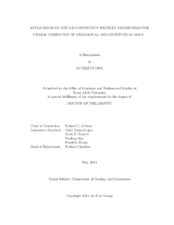| dc.description.abstract | Shatsky Rise, located in the northwest Pacific Ocean, is one of the largest oceanic plateaus. The origin and evolution of the oceanic plateaus are unclear because these features are remote and poorly imaged with geophysical data. Recently, marine multi-channel seismic (MCS) data were collected over Shatsky Rise to image its upper crustal structure. These data have the potential to improve understanding of the processes of basaltic volcanism and the formation and evolution of oceanic plateaus by providing direct insights into the geometry and distribution of igneous
eruptions. In contrast to sedimentary settings, it is often difficult to interpret deeper layers within basaltic crust because of rugged layering and scattering. Reflections in igneous crust are characterized by poor lateral continuity compared with marine sediments and often with weak impedance contrasts, resulting in lower signal-to-noise ratio and more challenging interpretation. In this dissertation, we apply the 2-D anisotropic continuous wavelet transform (CWT) method to improve interpretations of MCS data from the Shatsky Rise oceanic plateau. Applying the transform to the time-domain MCS profiles with appropriate values of wavelength and period produces new images with enhanced continuity of reflectors and reduced amplitudes of incoherent noise at different periods. The analysis of the results obtained by using 2-D CWT on the MCS data over the Tamu Massif part of the Shatsky Rise also helps reveal features such as dome-like bulges possibly associated with lava intrusion and faults in the deeper part of the crust associated with volcanic rock. These were not readily seen in the original seismic images, but the suppression of random noise and other signal with low coherence makes their interpretation possible. These and
similar results provide new insights into the complexity of the igneous processes forming Tamu Massif.
The other research topic is to apply the CWT analysis to characterize and mea-
sure the roughness of mineral surfaces to understand the effects of geochemical re-
actions on the surface of the mineral. The effects of the geochemical and environ-
mental reactions process are strongly related to the surface roughness. Because a
rough surface has a large number of molecules exposed with unfilled bonds, these
molecules have greater energy and react more readily. A thorough knowledge of the
surface roughness could lead to better understanding of geochemical reactions and
environmental effects on the mineral surface. We apply the 2-D CWT to character-
ize the surface of two samples of Fe_(2)O_(3) and three samples of calcite. For a fresh
surface of the calcite mineral, a cleavage plane exposed by fracturing, the surface
measurements show discrete jumps in height because of the limited resolution of
measurements. These stair-step-like features have been detected by using 2-D CWT
with wavelength of 32.2 µ .
Two other samples of calcite and two samples of Fe_(2)O_(3) show erosion effects and
are much rougher. In these cases, the application of 2-D CWT analysis helps to
localize the rough features at certain wavelengths of the wavelet, providing better
understanding of the characterization of surface roughness. These locations are asso-
ciated with the high energy surface where we expect the geochemical and weathering
reaction initially occur. In the future work, one could implement the 2-D CWT in-
version, allowing for the reconstruction of the surface of the mineral at selected wave-
lengths. Therefore we could observe directly the relationship between the roughness
and the wavelength. | en |


